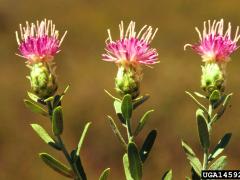Invasive Species: Acroptilon repens, Russian Knapweed
Russian knapweed is an invasive perennial forb that can grow to 3 ft. (1 m) in height. Stems originate from a basal rosette of leaves. The rosette leaves can be unlobed to very lobed and are 2 to 4 in. (5 to 10 cm) long. Stem leaves are oblong, pinnately lobed to entire, and up to 6 in. (15.2 cm) in length at the base of the stem; they become smaller and less lobed toward the top. In summer to fall, Russian knapweed produces flowers that are pink to purple and turn straw-colored as they mature. The flower heads are approximately 0.5 in (1.2 cm) in diameter and urn-shaped. Fruits (achenes) are ivory-colored with a tuft of hair that falls off at maturity. Russian knapweed is native to Eurasia and was introduced into the United States in the early 1900s. This species can cause chewing disease in horses.
What are invasive species and why should we be concerned about them?
Taxonomy: Scientific and Common Names for This Species
Asterales > Asteraceae > Acroptilon repens (L.) DC.
Synonym(s): Rhaponticum repens, hardheads
Acroptilon repens – USDA PLANTS Profile
Distribution Maps
Russian knapweed – The reported distribution of this invasive species across the United States. (Source: Invasive Plant Atlas of the United States)
Up-to-the-minute distribution maps and why they are important
Reporting This Invasive Species
What is the best way and place to report the occurrence of an invasive species?
How to report an invasive species sighting to EDDMapS – Early Detection & Distribution Mapping System
EDDMapS – Report an invasive species to EDDMapS
Cooperative Extension Offices – Find your local Cooperative Extension office on this map provided by USDA
How to Identify
This invasive species can be identified by looking for the characteristics described in the paragraphs that follow.
Plant
An invasive perennial forb that can grow to 3 ft. (1 m) in height. Stems originate from a basal rosette of leaves.
 |
 |
| Eric Coombs, Oregon Department of Agriculture, bugwood.org | Eric Coombs, Oregon Department of Agriculture, bugwood.org |
Foliage
The rosette leaves can be unlobed to very lobed and are 2 to 4 in. (5 to 10 cm) long. Stem leaves are oblong, pinnately lobed to entire, and up to 6 in. (15.2 cm) in length at the base of the stem; they become smaller and less lobed toward the top.
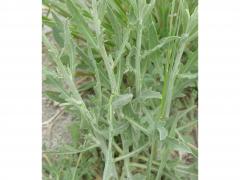 |
 |
| Bonnie Million, National Park Service, bugwood.org | Bonnie Million, National Park Service, bugwood.org |
Flower
In summer to fall, Russian knapweed produces flowers that are pink to purple and turn straw-colored as they mature. The flower heads are approximately 0.5 in (1.2 cm) in diameter and urn-shaped.
|
|
 |
| Steve Dewey, Utah State University, bugwood.org |
Steve Dewey, Utah State University, |
Fruit
Fruits (achenes) are ivory-colored with a tuft of hair that falls off at maturity.
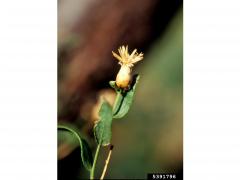 |
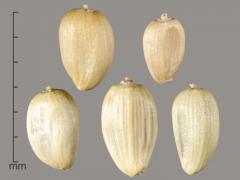 |
| John M. Randall, The Nature Conservancy, bugwood.org | Julia Scher, USDA APHIS PPQ, bugwood.org |
Native Species That Resemble Russian Knapweed
Centaurea americana, American star-thistle – Images at invasive.org
 |
 |
| Karan A. Rawlins, University of Georgia, bugwood.org | Karan A. Rawlins, University of Georgia, bugwood.org |
Vernonia gigantea, tall ironweed – Images at invasive.org
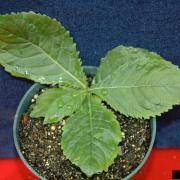 |
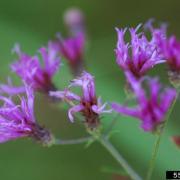 |
|
Bruce Ackley, The Ohio State University, |
Karan A. Rawlins, University of Georgia, bugwood.org |
Additional Images for Russian Knapweed
Russian knapweed – Images at Invasive.org
Learning Resources for Russian Knapweed
Additional Information, Biology, Control and Management Resources
Control and management recommendations vary according to individual circumstances. Location, habitat, weather, and a variety of other conditions are factors that help determine the best treatment choice. To find the safest and most effective treatment for your situation, consult your state’s land-grant institution. If you will use chemicals as part of the control process, always refer to the product label.
United States Land-Grant University System – Find your land-grant university’s College of Agriculture, Cooperative Extension Service, or other related partner on this map provided by USDA.
Invasives Database – Texas Invasives
Element Stewardship Abstract – The Nature Conservancy
Federal Noxious Weed Disseminules of the U.S. – USDA-APHIS
Fire Effects Information System – USDA Forest Service
Plant Factsheet – Colorado State University
Jepson Herbarium – University of California
Plant Profile – Cal-IPC

